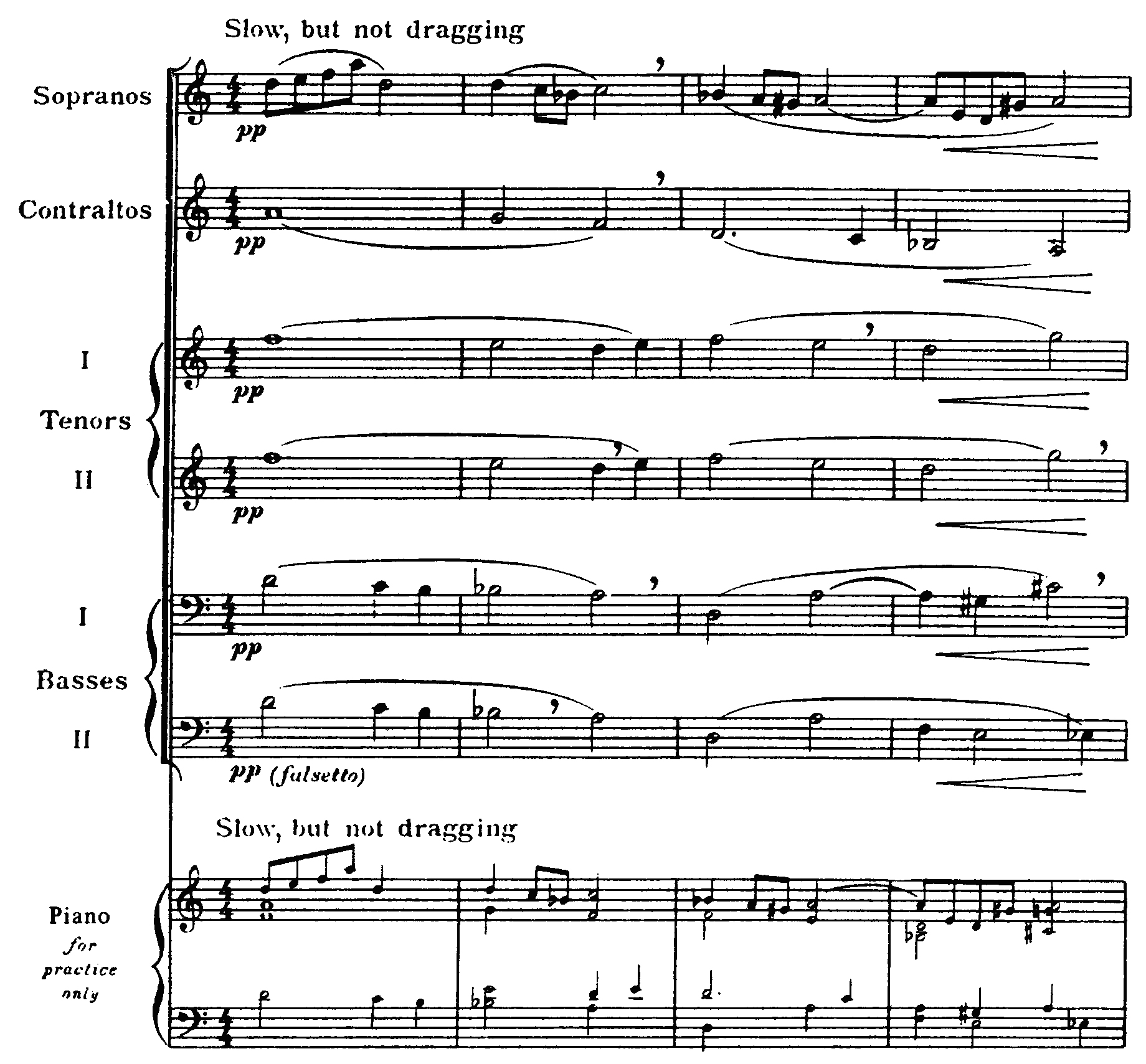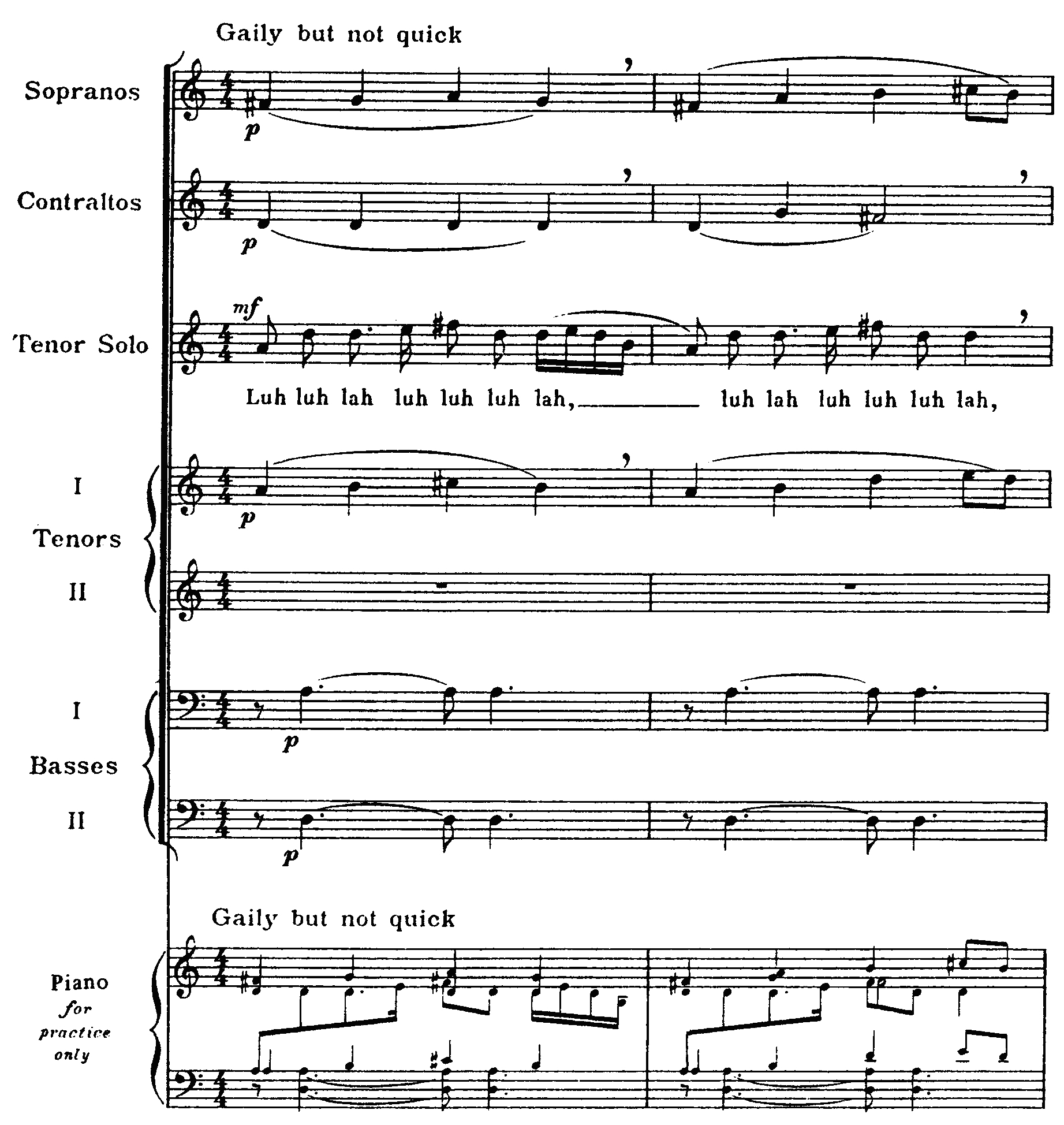Dramatic Vocalise Database
Frederick Delius (1862–1934)
To Be Sung of a Summer Night on the Water (1917)
During the period between the composition and premiere of The Song of the High Hills, Delius would once again turn to dramatic vocalization in the two wordless songs To Be Sung of a Summer Night on the Water (1917). These songs were written for Charles Kennedy Scott and his Oriana Madrigal Society, who gave the premiere at Aeolian Hall in London on 28 June 1921.
On the opening page of the first song Delius indicates the following in a footnote:
Sing on vowel “uh” (as in “love”) with very loose mouth, almost closed in the pianissimo, but which should be gradually opened or shut according as more or less tone is wanted. Breath should be taken only at the sign “ , ” if possible, and quietly and quickly in order to preserve the legato.1
At the opening, the sopranos sing the main melodic idea of the first song over the accompaniment of the other voices. This melody is similar to the main theme from The Song of the High Hills in both plaintive mood and melodic contour.

Delius, To Be Sung of a Summer Night on the Water, no. 1, mm. 1–4
2The second of the two songs is contrasting in its optimistic cheer; a lively solo tenor presents the song’s main thematic idea.

Delius, To Be Sung of a Summer Night on the Water, no. 2, mm. 1–2
3As in the previous song, Delius once again indicates in a footnote his intent as regards vowel selection:
The Solo voice should sing to syllables as indicated, introducing delicate staccati at appropriate places (which are generally where the syllables [sic] “luh” is put). On staccato notes the vowel should be sung for a very short time and the remainder of the notes continued on the sound of “l.”
The accompanying voices should sing on “uh” (as in “love”). A slight aspirate, though without taking the voice off before it, may be made at (1) all repeated notes and (2) the first note of slurs (unless it happen [sic] to come after a breath, in which case the aspirate is best omitted).4
Delius’s intent, as presented in the footnotes to both songs, differs greatly from The Song of the High Hills, where, as noted previously—“The chorus must be sung on the vowel which will produce the richest tone possible.” 5
The two songs of To Be Sung of a Summer Night on the Water mirror the two previous large-scale works, The Song of the High Hills and Appalachia. Together they serve as abbreviated versions, each corresponding to the mood of the prior works. In the orchestral works the initial choral entry is brief, and occurs approximately a third of the way through the piece. The chorus is kept from presenting the main theme of each work until near the end. When the chorus finally presents the theme in its entirety, the total length of the passage is equivalent to one of the two songs of To Be Sung of a Summer Night on the Water.
The first of the two songs has a melodic contour and sorrowful mood similar to the theme of The Song of the High Hills. The jovial spirit of the second song is similar to that of the main theme from Appalachia.

Delius, Appalachia, “main theme,” mm. 98–107
6Both the theme from Appalachia and the second song are in a major key and have a similar melodic contour—the beginning of both melodies features an arpeggiated second-inversion tonic triad. At times Delius’s music resembles the sound and syntax of Debussy, Ravel, and other French composers; however, as Delius himself said, this is probably more attributable to the influence of Wagner on all of them.7
(Nauman 2009, 137–41)
Examples | Comments |
| To Be Sung of a Summer Night on the Water, No. 1 |
| To Be Sung of a Summer Night on the Water, No. 2 |
Footnotes
1 Frederick Delius, To Be Sung of a Summer Night on the Water, ed. Sir Thomas Beecham, vol. 17 of Complete Works (New York: Boosey & Hawkes, 1952), 28.
2 Ibid.
3 Ibid., 32.
4 Ibid.
5 Frederick Delius, Brigg Fair and Other Favorite Orchestra Works, 146.
6 Frederick Delius, Appalachia, 20–21.
7 See Richard Greene’s quote regarding Holst’s, The Planets.